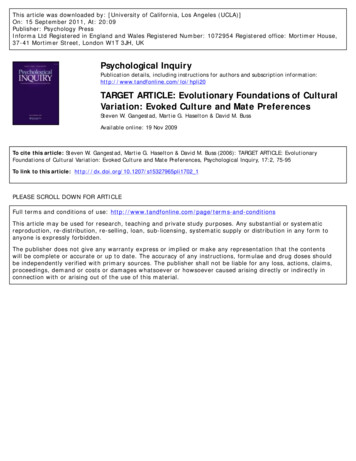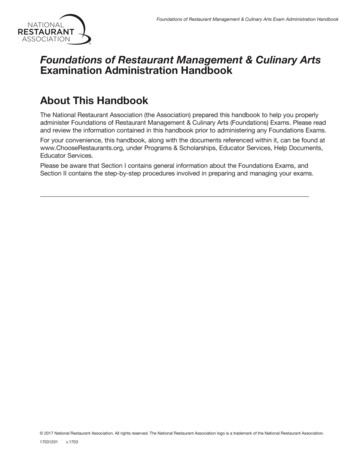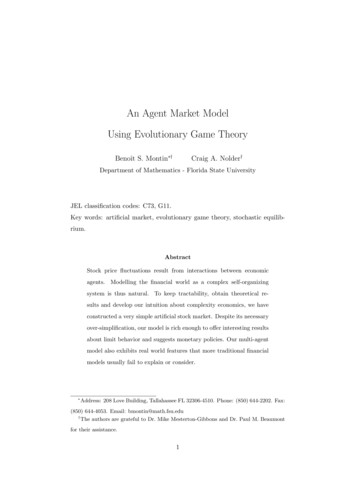
Transcription
This article was downloaded by: [University of California, Los Angeles (UCLA)]On: 15 September 2011, At: 20:09Publisher: Psychology PressInforma Ltd Registered in England and Wales Registered Number: 1072954 Registered office: Mortimer House,37-41 Mortimer Street, London W1T 3JH, UKPsychological InquiryPublication details, including instructions for authors and subscription ARGET ARTICLE: Evolutionary Foundations of CulturalVariation: Evoked Culture and Mate PreferencesSteven W. Gangestad, Martie G. Haselton & David M. BussAvailable online: 19 Nov 2009To cite this article: Steven W. Gangestad, Martie G. Haselton & David M. Buss (2006): TARGET ARTICLE: EvolutionaryFoundations of Cultural Variation: Evoked Culture and Mate Preferences, Psychological Inquiry, 17:2, 75-95To link to this article: http://dx.doi.org/10.1207/s15327965pli1702 1PLEASE SCROLL DOWN FOR ARTICLEFull terms and conditions of use: nsThis article may be used for research, teaching and private study purposes. Any substantial or systematicreproduction, re-distribution, re-selling, loan, sub-licensing, systematic supply or distribution in any form toanyone is expressly forbidden.The publisher does not give any warranty express or implied or make any representation that the contentswill be complete or accurate or up to date. The accuracy of any instructions, formulae and drug doses shouldbe independently verified with primary sources. The publisher shall not be liable for any loss, actions, claims,proceedings, demand or costs or damages whatsoever or howsoever caused arising directly or indirectly inconnection with or arising out of the use of this material.
Psychological Inquiry2006, Vol. 17, No. 2, 75–95Copyright 2006 byLawrence Erlbaum Associates, Inc.TARGET ARTICLEDownloaded by [University of California, Los Angeles (UCLA)] at 20:09 15 September 2011Evolutionary Foundations of Cultural Variation:Evoked Culture and Mate PreferencesSteven W. GangestadDepartment of PsychologyUniversity of New MexicoMartie G. HaseltonCommunication Studies and Department of PsychologyUniversity of California at Los AngelesDavid M. BussDepartment of PsychologyUniversity of Texas at AustinWe articulate an evolutionary perspective on cultural variation, centering on the concept of evoked culture. We then demonstrate how the framework of evoked culture hasbeen used to predict and explain cultural variation and report new tests of hypothesesabout cultural variation in mate preferences. These tests demonstrate the predictivepower of ecological variables such as parasite prevalence that are implicated by evolutionary psychological theories. New empirical tests provided little support for thepredictions advanced by competing social role theories (e.g., Eagly & Wood, 1999),with some findings running opposite to those predicted by such theories. We proposethat a well-articulated evolutionary perspective on cultural variation may be particularly useful because it can specify how variation in cultural practice itself mayemerge. We conclude that discussions of cultural variation should move beyond falsedichotomies of social versus biological and suggest that evolutionary psychology provides frameworks that transcend these dichotomies.In the cross-cultural record, two facts stand out.First, people in different cultures vary widely in theirbehavior, beliefs, and practices. Substantial culturalvariation exists in just about every arena of human life,from subsistence strategies, food sharing, and childcare arrangements to religious beliefs, body decoration, and leisure time pursuits. Second, human universals underlying this cultural variation abound (Brown,1991). Thus, although marriage arrangements varywidely across human societies, long-term, culturallyrecognized, and sanctioned pair bonds occur in all human groups (Murdock, 1949); special terms distinguishing kin exist in all natural languages (Brown,1991); everywhere, basic facial expressions appear tobe interpreted similarly (Ekman et al., 1987); and in allknown cultures, men are overwhelmingly the perpetrators of murder (Buss, 2005; Daly & Wilson, 1988).A comprehensive understanding of human behavior must account for universal features as well asvariation between and within cultures. Some theoriestended to focus on one or the other. Nativist theoriestypically emphasize the universals of human life, proposing a basic human nature that is relatively unchanged across time and place (e.g., Lorenz, 1963).Cultural variation, in many of these views, is a thinveneer obscuring a clear view of invariant commonalities. By contrast, social constructionist models generally focus on the particulars of individual culturesand variations among them (e.g., Geertz, 1973, 1983;Shweder, 1990). Because many of these theories propose or imply that the differences in individuals’ beliefs and practices across cultures arise from exposureto different cultures, these theories explained the coreelements of cultural practice by invoking individuals’
Downloaded by [University of California, Los Angeles (UCLA)] at 20:09 15 September 2011GANGESTAD, HASELTON, BUSSexperiences rather than intrinsic generative processesof human nature.Most theorists recognize that genes and environment influence behavior only in a context partly defined by the other, such that a dichotomy between nature and nurture (the idea that influence can beunderstood through reference to only genes or environment, respectively) is wrongheaded. Behavior resultsfrom an underlying, often universal, evolved developmental system (itself consisting of both genetic and environmental components) in conjunction with individual environmental influences, including socialexperiences. This developmental system gives rise topsychological traits. In some cases (e.g., binocular vision), canalization may be sufficiently strong such thatunder all normal developmental environments, thetraits are universally invariant. In other cases, evolveddevelopmental systems are designed to produce variable phenotypic traits, contingent on variable environments. In all cases, however, universal invariance orvariable traits are outcomes of systems. One role oftheory is to specify how evolved developmental systems and psychological adaptations translate variableenvironments into behavioral outcomes, thus creatingvariation within and between cultures.This view implies that it is meaningless to place thecause of human behavior either in the individual’s essential character or in the environment. Hence, it ismisleading to state that behavioral variants are “due to”environmental variation, even when all behavioralvariation systematically covaries with environmentalvariation. We describe several examples throughoutthis article but consider a simple, nonpsychological example. Variation in skin tanning covaries strongly withamount of environmental exposure to sunshine. Acomprehensive understanding of this variation, however, requires knowledge of the underlying biologicaladaptation for protective tanning that is designed to respond to sunshine by producing melanin. The only waythat environmental variation can produce behavioralvariation is via an underlying evolved system, whichany complete understanding of the behavioral variationmust describe. This view also implies that behavioralvariation due to environmental variation cannot beconstrued as a superficial veneer overlying an essentialcore. When an underlying psychology is designed toproduce behavioral variation across different life circumstances, the underlying psychology cannot be separated from the existence of behavioral variation. Humans are essentially neither aggressive nor peaceful,monogamous nor polygynous; rather, humans respondaggressively or cooperatively and mate monogamously or polygynously depending on specific life histories and current environmental arrangements.Where reasoned debate remains, it largely concernsthe precise ways through which evolved systems giverise to universal or variable outcomes. Evolutionary76psychology offers one lens through which to view andexplore the nature of these systems. Although evolutionary psychology can and has been used to identifyand explain psychological features that are universal ornear-universal (e.g., Brown, 1991), it can also identifyand explain psychological features that are highly variable across cultures.Most participants in contemporary scientific debates about culture do not propose that genes or environment can operate alone. Nevertheless, there is significant ongoing debate about just what aninteractionist perspective on culture entails (Eagly &Wood, 1999; Kasser & Sharma, 1999) as well as howan evolutionary psychological approach can be used tounderstand cultural variation, if at all (Wood & Eagly,2000a, 2000b, 2002; Rabinowitz & Valian, 2000).The primary purpose of this article is to articulatehow evolutionary psychological theory founded onspecialized psychological adaptations can be used topredict and explain cultural variation. As an illustration, we use cross-cultural data on mate preferences. Inour analyses, we test new evolutionary predictionsabout cultural variation. We argue that an evolutionarypsychological perspective on cultural variation canprovide a deeper explanation of cultural variation inbehavior than alternative theories because it can specify how variation in cultural practice itself mayemerge.Cultural Variation and EvolutionaryPsychologyThe Evolution of EnvironmentalContingencyHistorically, general learning theories characteristicof the behaviorist approach in psychology emphasizedthe ways by which environmental arrangements affectbehavior (e.g., Hull, 1943). Even these theories did notignore the nature of an evolved, adaptive system bywhich environmental influence occurs. Darwin is mentioned on the first page of Hull’s (1943) Principles ofBehavior and a second (and last) time several pageslater, where his effect on Hullian theory is revealed:Adaptive adjustments to initial response hierarchiesare made through the process of drive reduction,whereby drives are based on fundamental requirements for survival and reproduction, such as food, water, and sex. According to this view, then, organismsmake adaptive adjustments to situations through a single evolved process: drive reduction. Subsequent behaviorists such as B. F. Skinner (1981) also recognizedthe critical role of adaptation and natural selection.Some presented compelling evidence for the existenceof multiple evolved learning mechanisms—adaptations for food conditioning, for example, differ qualita-
Downloaded by [University of California, Los Angeles (UCLA)] at 20:09 15 September 2011EVOLUTIONARY FOUNDATIONS OF CULTURAL VARIATIONtively from those for sexual conditioning (Domjan,1997; Garcia & Koelling, 1966; Herrnstein, 1977).Evolutionary psychologists also argue that animalsadjust their behavior adaptively in response to the particular environmental arrangements that confrontthem. In contrast to early general learning theories,however, this approach proposes that adaptive adjustment cannot be accounted for by a single evolved process, as selection is unlikely to favor such an outcome.Though organisms should be designed to behave inways responsive to their particular environments, “[developmental and psychological] designs that produce‘plasticity’ can be retained by selection only if theyhave features that guide behavior into the infinitesimally small regions of relatively successful performance with sufficient frequency” (Tooby & Cosmides,1992, p. 101). A contingent patterning of behavior thatoccupies these small regions of performance is likelyto require developmental and psychological adaptations that are specific to particular problem domains(Barrett, 2005; Tooby & Cosmides, 1992).The problem-specific nature of adaptations can beillustrated with several physiological adaptations.Some skin tissue is designed to callus when abraded.Other skin tissue increases melanin production in response to exposure to sunlight. The pupil of the eye isdesigned to constrict or enlarge in response to lightingintensities. The immune system has a specific capability to “learn” how to recognize self and attack nonselfentities to which it is exposed. These systems share acommon feature, environmental contingency, whichpermits the organism to adaptively adjust to its individual circumstances. This common feature should notobscure the fact that these evolved systems are clearlydistinct and responsive in their own highly particularways to circumstances, which can be understood interms of the specific problems they evolved to solve(i.e., specific selection pressures that gave rise tothem).The evolutionary psychological perspective arguesthat brains, too, should consist of adaptations specialized for specific functions in response to particular selection pressures. Only a brain that organizes responses to particular aspects of the environment in anadaptively targeted fashion could be expected to be biologically successful. Hence, adaptations that underlievisual perception and language production should contain specialized design features partly or wholly distinct from adaptations that underlie competition forand selection of mates, which should have design features distinct from those underlying kin recognition,cooperative social relations, or foraging decisions.Many perspectives acknowledge the existence ofdistinct psychological systems accounting for adaptiveadjustment. Few psychologists would claim, for instance, that the processes underlying color constancyachieved in variable lighting conditions are the same asthose underlying language learning. Evolutionary psychology is unique in its argument that discovery of thedesign of these systems is fostered by the explicit aid ofevolutionary theories about the selective environmentsin which the systems evolved.Environmental Contingency in MatingStrategiesThe heuristic value of the evolutionary approach isillustrated by work on nonhuman species. Behavioralecologists study how animals adaptively adjust theirbehavior to their ecologies. They generally assume thatadaptive adjustments are problem-specific and involvea multiplicity of adaptations (e.g., Krebs & Davies,1993). Consider, for example, the collared flycatcher, abird species on the island of Gotland in the Baltic Sea.Male and female pairs form socially monogamous unions. Nonetheless, about 15% of eggs are sired by extra-pair males. When sexually mature, males develop apatch of white feathers on their foreheads, and maleswho sport larger patches account for a disproportionatenumber of the extra-pair fertilizations (Sheldon &Ellegren, 1999). Behavioral ecologists speculated thatthese males are selected as extra-pair mates becauseforehead patches are sexually selected indicators ofgood genes. As predicted by this hypothesis, (a) females whose social mates have relatively small forehead patches are particularly likely to engage in extra-pair copulations (Sheldon, Davidson, & Lindgren,1999); (b) females tend to seek extra-pair matingswhen they are most fertile (Michl, Torok, Griffith, &Sheldon, 2002); (c) offspring of males with large forehead patches are in better condition (as measured bystandard body weight assessments) compared to theirhalf-siblings who are sired by the female’s social mate(Sheldon, Merila, Qvarnström, Gustafsson, &Ellegren, 1997); (d) the offspring of males with largeforehead patches tend to be male, the sex that mostbenefits from having such a sire (Ellegren, Gustafsson,& Sheldon, 1996), which suggests that flycatchersadaptively adjust the sex ratio of offspring dependingon their own qualities or the qualities of their mates. Itis implausible that the adaptive adjustments of the mating behavior of collared flycatchers are due to adaptations that affect all of their other behavior, such as howthey learn and remember food sources or how they engage in other social interactions. Rather, just as specific skin tissue of humans responds to sunlight by producing melanin, specific mating behaviors of collaredflycatchers appear to have been specially shaped to beconditional on specific, context-meaningful environmental features. Discovery and understanding of theseconditional responses would have been unlikely if notfor explicit evolutionary theory about sexual selectionon these birds.77
Downloaded by [University of California, Los Angeles (UCLA)] at 20:09 15 September 2011GANGESTAD, HASELTON, BUSSHumans should also possess a psychology that issensitive to a large number of adaptively relevant environmental variables. To illustrate, we consider an example analogous in many ways to the context-specificresponses of the collared flycatcher. Recent researchhas shown that changes in women’s sexual preferencesand interests are intricately patterned. Fertile womenparticularly prefer the scent of men who evidence a robust developmental history, as indicated by phenotypiccues such as bodily symmetry (Gangestad & Thornhill,1998; Rikowski & Grammer, 1999; Thornhill &Gangestad, 1999b; Thornhill et al., 2003), more masculine faces (Johnston, Hagel, Franklin, Fink, &Grammer, 2001; Penton-Voak et al., 1999;Penton-Voak & Perrett, 2000), and male behavioraldisplays of social presence and intrasexual pgar, & Christensen, 2004). These shifts appear to be specific to when women evaluate men asshort-term sex partners, not long-term mates(Gangestad et al., 2004; Haselton & Miller, 2006;Penton-Voak et al., 1999). Yet not all desired traits aremore preferred near ovulation. For instance, traits particularly valuable in long-term mates, such as resources, do not show ovulatory increases in femalepreference (Gangestad, 2004; Haselton & Miller, inpress; see also Thornhill et al., 2003). The only explanation as yet proposed to account for these changes isthat selection has shaped female preferences for indicators of genetic benefits to offspring in short-termmates to be enhanced mid-cycle—the time whenwomen could have benefited by mating with such partners. Indeed, women appear to show particular sexualinterest in men other than primary social partners whenthey are fertile (Bellis & Baker, 1990; Gangestad,Thornhill, & Garver, 2002; Haselton & Gangestad,2006; but see also Pillsworth, Haselton, & Buss, 2004).And emerging evidence suggests that women withpartners lower on hypothesized fitness indicators arethose whose preferences for extra-pair partners are particularly likely to increase as ovulation approaches(Haselton & Gangestad, 2006; Gangestad, Thornhill,& Garver-Apgar, in press).This same line of research has demonstrated a variety of additional context-specific conditional responses: (a) Women’s primary male partners respondcontingently based on correlates of their fertility status; men appear to be more vigilant of the whereabouts of partners who are in fertile phases than thosesame partners in nonfertile phases (Gangestad et al.,2002; Haselton & Gangestad, 2006); (b) women whosee themselves as physically attractive particularlyprefer masculine faces, presumably because they facesmaller trade-offs between qualities advertised by facial masculinity and the effort a partner invests in therelationship, and hence are more able to commandboth (Little, Burt, Penton-Voak, & Perrett, 2001); (c)78when women particularly value investment in a relationship from a man, they may prefer less masculinefaces (Penton-Voak, 2001); (d) when women pursue ashort-term mating strategy, they show an elevatedpreference for men who are physically attractive andsexy (Buss & Schmitt, 1993; Greiling & Buss, 2000).In sum, the available evidence points to an intricatelydesigned, environmentally sensitive psychological architecture.Women’s sexual interests are dependent on external factors, such as relationship context (short termvs. long term) and partner quality, as well an important internal cue, her cyclical fertility status. Considered as a whole, the patterning of women’s sexualinterests and preferences cannot be understood as aset of contingent responses that have been shaped bybroad, domain-general learning processes. Rather, thecontingent nature of these interests is best explainedby invoking the concept of evolved psychological architecture containing design features dedicated tosolving specific adaptive problems in the domain ofmating.This area of research provides an example in whichvariable contemporaneous inputs produce changes inpsychological and behavioral outputs. Evolutionarypsychologists also expect responses to environmentalfactors that may developmentally calibrate or condition psychological adaptations, producing more stabledifferences between individuals occupying differentecologies (Buss, 1991; Tooby & Cosmides, 1990). Inshort, this conceptual framework points to the possibility of specialized, problem-specific adaptations underlying patterns of within-group similarity and between-group difference—what scientists often refer toas culture.Evoked and Transmitted CultureCulture can be conceptualized as sets of practices,beliefs, ideas, values, inventions, artifacts, and attitudes that characterize groups of people. There are atleast two pathways through which cultural variationmay emerge: transmission and evocation.First, the elements of culture may be acquiredthrough modeling or social learning and transmittedthroughout a population. This is, of course, the dominant view in the social sciences and is likely one majorsource of cultural variation. For example, the development and retention of cumulative knowledge in theform of technology (e.g., canoe-making, agriculturalpractices, systems of mathematics) is probably best explained by cultural transmission (see, e.g., Boyd &Richerson, 1985, Henrich & Gil-White, 2001; see alsoFlinn, 1997).Second, some variation across cultures may be understood in terms of differences in the social and ecological conditions within which groups live and the
Downloaded by [University of California, Los Angeles (UCLA)] at 20:09 15 September 2011EVOLUTIONARY FOUNDATIONS OF CULTURAL VARIATIONspecially designed adaptations humans have for responding to them. Tooby and Cosmides (1992) introduced the term “evoked culture” to refer to the fact thatthese conditions (e.g., war, drought, abundance) provide inputs for a richly responsive domain-specificpsychology and thereby “evoke” different behavioralrepertoires, forging different elements of culture. Thespecific content and organization of culture, then, ispartly a product of domain-specific phenotypic sensitivities to environmental input in conjunction with specific input. Metaphorically, evoked cultural variationcan be understood in terms of a specially programmedjukebox (Tooby & Cosmides, 1992). The jukebox isdesigned to play a different song depending on environmental inputs (e.g., temperature, population density). As the jukebox is moved from one environmentto another (or as environments change temporally), thejukebox plays different tunes. The variable tunesplayed under specific conditions are due to the jukebox’s design in concert with specific environmental inputs (see also Kenrick, Li, & Butner, 2003). To proposethat this process accounts for some important forms ofcultural variation is not to deny that human learning occurs but rather to shift the emphasis toward understanding how selection has shaped domain-specificphenotypic sensitivities to environmental inputs.The preceding discussion of specialized contingentresponses points to one set of paths by which culturemay be evoked. In socioecological circumstances inwhich women should particularly value male relationship investment, they may prefer less masculine faces;when investment is not especially valued, or whenwomen anticipate only short-term mating, women’spreferences may shift to more masculine faces andother characteristics indicative of good genes(Penton-Voak, 2001).How Cultural Variability May ReflectEvoked CultureIn this section, we discuss in greater detail two examples of how evolutionary scientists predicted andexplained cultural variation in terms of specialized adaptations through which particular circumstancesevoke different practices and preferences. (For additional examples see Alexander, Hoogland, Howard,Noonan, & Sherman, 1979; Gaulin & Boster, 1992;Holden & Mace, 1999; Mace & Holden, 1999;Schmitt, 2005.)Mate Preferences and Women’sContribution to Direct ProductionCalorie production by men and women. Kaplan,Hill, Lancaster, and Hurtado (2000) argued that a significant aspect of hominid evolution giving rise to longlife spans, prolonged investment in juveniles, and largebrain size is that, compared to our nearest relatives, humans consume high-quality but difficult to extract resources such as animal protein. Whereas chimpanzeesobtain about 95% of their calories from collected foodsrequiring no extraction (e.g., fruits, leaves), only about8% of calories consumed by modern hunter-gatherersare from foods requiring no extraction. Both men andwomen contribute substantially to their own subsistence. In the majority of hunter-gatherer populationsstudied to date, however, the average male adult generates more calories than he consumes—mostly throughhunting. These food resources yield benefits for reproductive women and juveniles by providing extra calories and macronutrients such as protein. Marlowe(2001) estimated that, on average, men produced 64%of the calories in all 95 foraging societies on which sufficient information is available. In Kaplan et al.’s(2000) analysis of studies that carefully measured produced foods in nine hunter-gatherer societies, mengenerated on average about 66%.1 No such surplus ofcalories is generated by male chimpanzees. Women intraditional societies can and do turn the surplus of calories generated by men into production of offspring andthereby reproductively benefit from this surplus generated through male hunting (Marlowe, 2001).1Broader samples of cultures (such as the widely used 186-cultureStandard Cross-Cultural Sample) include societies with more developed forms of agriculture, which may be less relevant to an understanding of human societies prior to the past 10,000 years. Nonetheless, estimates based on them are similar: 65% in the StandardCross-Cultural Sample (Schlegel & Barry, 1986) and 65% in a broadersample of 499 societies (Sanday, 1973). Wood and Eagly (2002) citedAronoff and Crano’s (1975) mean estimate of 44% of female contribution to subsistence (56% male contribution), based on 862 societies.As was noted in a response by Carroll (1976), this estimate deviatesfrom others, for reasons that an exchange was unable to fully resolve.We noticed that Table 3 of Aronoff and Crano, which reported agrouped relative frequency distribution of female contribution to subsistence across all 862 societies, implies a possible range of 33% to42% for the mean, with a best guess of 38%—close to other mean estimates. Thus, their calculation appears not to have been the average ofall societies’ female contributions to subsistence, which probably explains the deviation of their figure from others.The implications of this surplus for an understanding of humanmating and parenting is a matter of debate. Hawkes and colleagues(e.g., Hawkes, 1991; Hawkes, O’Connell, & Blurton Jones, 1991;Hawkes et al., 2001) argued that men in hunter-gatherer groups (e.g.,the Hadza and Ache) have little opportunity to direct resources totheir own mates and kin, and, hence, their hunting has not evolved asa means of directly providing nutritional benefits to mates and offspring. Kaplan et al. (2000) argued that these male activities havebeen shaped by selection to partly function as parenting effort. AsHawkes et al. (2001) acknowledged, the wives and children of goodhunters in the Hadza are better nourished and, hence, even if malehunting has not evolved for family provisioning, the average ancestral woman could have materially benefited from choosing a manwith better access to resources (e.g., through men’s enhanced statusamong men and thereby their ability to protect mates). Indeed, theynote that Hadza women prefer to marry good hunters.79
Downloaded by [University of California, Los Angeles (UCLA)] at 20:09 15 September 2011GANGESTAD, HASELTON, BUSSVariation in benefits to women through male caloric subsidies. Although women’s work is clearlyimportant to child outcomes (e.g., Hawkes et al.,2001), in traditional cultures women’s direct production of nutritional resources may interfere with their reproduction by increasing the interval between birthsand thereby reducing offspring number (e.g., Schlegel& Barry, 1986; see also Kaplan et al., 2000). Hence,across foraging societies, greater male contribution todiet is associated with greater female reproductive success (Marlowe, 2001). Men may also benefit from mating with efficient, industrious mates but not necessarilyones who invest considerable effort into access to resources or status competition. Thus, as Buss (1989)predicted and found, modern women across a range ofdiverse cultures do appear to place greater emphasis ona mate’s access to resources than men do (see alsoBuss, Shackelford, Kirkpatrick, & Larsen, 2001;Kenrick & Keefe, 1992; Sprecher, Sullivan, & Hatfield, 1994; Wiederman, 1993).In foraging populations, however, the degree towhich women and juveniles benefit from male huntingvaries. Indeed, in many groups that particularly rely ongathered (as opposed to hunted) foods, women generate more calories than do men (Kaplan et al., 2000;Marlowe, 2001; Sanday, 1973; Schlegel & Barry,1986). The variation partly depends on ecological factors (e.g., Marlowe, 2001; Wood & Eagly, 2002).Women can generate dietary resources at a greater ratein some environments than in others (even while caringdirectly for offsp
tion, we use cross-cultural data on mate preferences. In our analyses, we test new evolutionary predictions about cultural variation. We argue that an evolutionary psychological perspective on cultural variation can provide a deeper explanation of cultural variation in behavior than alternative theories because it can spec-










